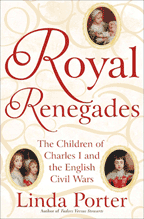Exclusive interview with author Linda Porter discussing her new book about the children of Charles I and the English Civil Wars
By Gabrielle Pantera
 “I suspect if you stopped eight out of ten people on a British street they would be surprised to learn that we executed Charles I for treason in 1649 and were a republic for eleven years afterwards,” says Royal Renegade author Linda Porter. “It is the sort of thing that would give the Brexit brigade the shivers. I had previously written three books about the Tudors, the last of which covered also the Stewarts in Scotland, as opposed to the Stuarts in England, so it was something of a natural progression, I suppose. I love the period of the English Civil Wars, the fulcrum of our history, in my view, though sadly neglected in schools here nowadays.”
“I suspect if you stopped eight out of ten people on a British street they would be surprised to learn that we executed Charles I for treason in 1649 and were a republic for eleven years afterwards,” says Royal Renegade author Linda Porter. “It is the sort of thing that would give the Brexit brigade the shivers. I had previously written three books about the Tudors, the last of which covered also the Stewarts in Scotland, as opposed to the Stuarts in England, so it was something of a natural progression, I suppose. I love the period of the English Civil Wars, the fulcrum of our history, in my view, though sadly neglected in schools here nowadays.”
After the English Civil War and the execution of King Charles I, his son Charles II bided his time to reclaim the throne eleven years later. But King Charles I had six other surviving children. What happened to them? Porter sheds new life on the lives of Charles II siblings and reveals all sorts of drama in this family of royals. Mary, the Princess Royal, became the child bride of the Prince of Orange in the Netherlands. Mary was the first daughter of a British sovereign to hold the title Princess Royal. Later her son became William III of England.
“Even where people are aware of the Civil Wars, few know that Charles I had five surviving children at the start of the conflict and a sixth, his youngest daughter, actually born during the wars, at Exeter in 1644,” says Porter. “Their experiences as a family are a microcosm of what happened to many people during this tumultuous period and the children’s stories are, almost universally, very tragic. This is not a tale with a happy ending.”
Porter says she took the same approach to research this book that she always does.
“First I read the latest scholarly books on the topic,” says Porter. “Then I look at more standard monographs. Then at printed sources and then at archival sources. This is how I was taught to do historical research many years ago, and it is second nature to me. In terms of sources, there is much more material available on the seventeenth century than the Tudor period, simply because it is closer to us in time. I also consult academic specialists in the period.”
“I go to the normal places one goes in the UK for archival research,” says Porter. “The British Library and the National Archives. I also look at private family papers where accessible. Many people describe themselves as historians. But, do not have a background in history, do not in my view, know how to do historical research properly. People with a background in journalism are particularly prone to dash off history books.”
“Readers should be aware that there is more to the history of the British Isles than the Tudors,” says Porter. “I am quite relieved to have escaped them. I would like to write about the French Revolution, which is where I started out as an historian. As it happens, I prefer French history. But, most British publishers feel, rightly or wrongly, that there is a better market for British history. My favorite period is the French Revolution…the crossroads, where the eighteenth century enters the modern world.”
Porter has written three other books, on Mary Tudor, Katherine Parr and the backstory of Mary Queen of Scots. Porter won the 2004 Daily Mail Biographers Club Prize, for a book on the Bonapartes (yet to be published). He is currently writing a book on the mistresses of Charles II.
Porter is based in the southeast of England and born in Exeter. Her website is www.lindaporter.net. She is active on Facebook.
Royal Renegades: The Children of Charles I and the English Civil Wars Hardcover by Linda Porter. February 20, 2018 ISBN-13: 978-1250055422 $28.99
